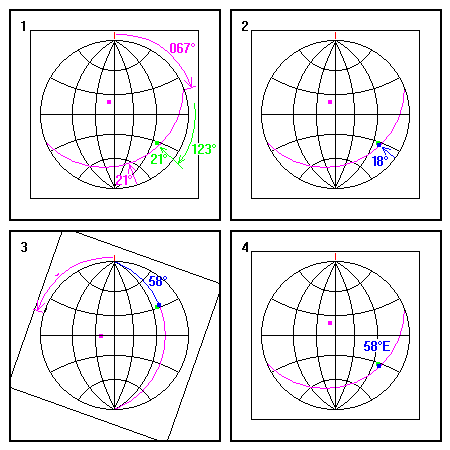Use a Stereonet to Find the Pitch of a Line Given Attitude Data
Steven Dutch, Professor Emeritus, Natural and Applied Sciences, University of Wisconsin - Green Bay
Example
A sandstone bed strikes 067 and dips 21 degrees SE. In the bedding plane we find ripple marks trending 123 and plunging 21 degrees. What is their pitch in the bedding plane? Pitch is the angle between a line in a plane and the horizontal, measured in the plane. Thus, this problem is nothing more than determining the angle between two lines: the measured line and a horizontal line.
Right away we have a problem. A line in a plane can never plunge more steeply than the plane, and can only have a plunge equal to the dip if the line plunges exactly down dip. Since the downdip direction on the plane is 067 + 90 = 157, clearly the actual plunge of the ripple marks must be less than 21 degrees. The plunge measurement must be in error.
Almost always, the measured orientation of the line will never coincide exactly with that of the plane because of observational error and variability in the data. So the solution is to plot the data as measured and then adjust accordingly.
 |
1. Plot the plane and the line. 2. It turns out the line as measured lies about 3 degrees off the plane. This is not a serious disagreement and can easily arise in actual field measurements. So plot the point on the plane nearest the measured orientation of the line (shown in blue). 3. Rotate the overlay so the bedding plane lies on a great circle, and measure the angle between a horizontal line and the line in the plane. 4. Rotate the overlay to its original position and note which strike direction the pitch is measured from. |
Return to Course Syllabus
Return to Techniques Manual Index
Return to Professor Dutch's Home Page
Created 14 September 2000, Last Update 14 September 2000